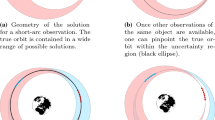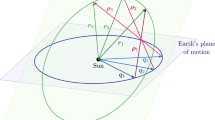Abstract
Orbits of objects in cislunar space are, in general, non-Keplerian due to the influence of the Moon’s gravity and cannot be generically parameterized by a simple set of characteristics. Objects are also fainter and move relatively more slowly when viewed from Earth. Detection and tracking are expected to be significantly more difficult and, as a consequence, orbit determination becomes more challenging. In this paper we review a subset of possible orbits and their expected astrometric and photometric signatures from the perspective of hypothetical ground-based electro-optical sensors on Earth. Although a multitude of orbits are possible, we focus on special types of orbits that are closed in the synodic frame (i.e., periodic) and emanate from the libration points of the Earth-Moon system. We investigate three separate elemental periodic orbit families that have been differentially corrected in a high-fidelity dynamical system: H1, L1, and W4W5. For each family, we set objects at different locations at different epochs and simulate the expected observational features (e.g., right ascension, declination, visual magnitude) based on faceted satellite models. In this study, we show how Gaussian mixture model estimation filters behave when processing different observation sets, specifically varying data cadence, data density, data quality, and data span. Convergence and uncertainty bounds are shown to have a strong dependence on the observational data composition (affecting the accuracy of fitting orbits) and a notable correlation to orbital stability (affecting the ability to predict/correct orbits).









Similar content being viewed by others
Notes
The \(\mathcal{L}1\) Halo family (i.e., H1) is truncated to include only the orbits that span the bifurcation points between the \(\mathcal{L}1\) Lyapunov family (i.e., L1) and the W4W5 axial family.
Up to the accuracy of a user’s force model configurations and convergence tolerances.
References
Chow, C., Wetterer, C., Hill, K., Gilbert, C., Buehler, D., Frith, J.: Cislunar periodic orbit families and expected observational features. In: Proceedings of the advanced Maui optical and space surveillance technologies (AMOS) Conference, Maui, HI, September 15–18, 2020
Doedel, E., Romanov, V., Paffenroth, R., Keller, H., Dichmann, D., Galan-Vioque, J., Vanderbauwhede, A.: Elemental periodic orbits associated with the libration points in the circular restricted 3-body problem. Int. J. Bifurc. Chaos 17(8), 2625–2677 (2007)
Vutukuri, S.: Spacecraft trajectory design techniques using resonant orbits. M.S. Dissertation, Purdue University, West Lafayette, IN (2018)
Hughes, S., Qureshi, R., Cooley, S., Parker, J.: Verification and validation of the general mission analysis tool (GMAT). https://doi.org/10.2514/6.2014-4151 (2014)
DeMars, K., Bishop, R., Jah, M.: Entropy-based approach for uncertainty propagation of nonlinear dynamical systems. J. Guidance Control Dyn. 36(4), 1047–1057 (2013)
Author information
Authors and Affiliations
Corresponding author
Ethics declarations
Conflict of interest
On behalf of all authors, the corresponding author states that there is no conflict of interest.
Additional information
Publisher's Note
Springer Nature remains neutral with regard to jurisdictional claims in published maps and institutional affiliations.
This article belongs to the Topical Collection: Advanced Maui Optical and Space Surveillance Technologies (AMOS 2021) Guest Editors: Lauchie Scott, Ryan Coder, Paul Kervin, Bobby Hunt.
Rights and permissions
Springer Nature or its licensor (e.g. a society or other partner) holds exclusive rights to this article under a publishing agreement with the author(s) or other rightsholder(s); author self-archiving of the accepted manuscript version of this article is solely governed by the terms of such publishing agreement and applicable law.
About this article
Cite this article
Chow, C.C., Wetterer, C.J., Baldwin, J. et al. Cislunar Orbit Determination Behavior: Processing Observations of Periodic Orbits with Gaussian Mixture Model Estimation Filters. J Astronaut Sci 69, 1477–1492 (2022). https://doi.org/10.1007/s40295-022-00347-7
Accepted:
Published:
Issue Date:
DOI: https://doi.org/10.1007/s40295-022-00347-7




